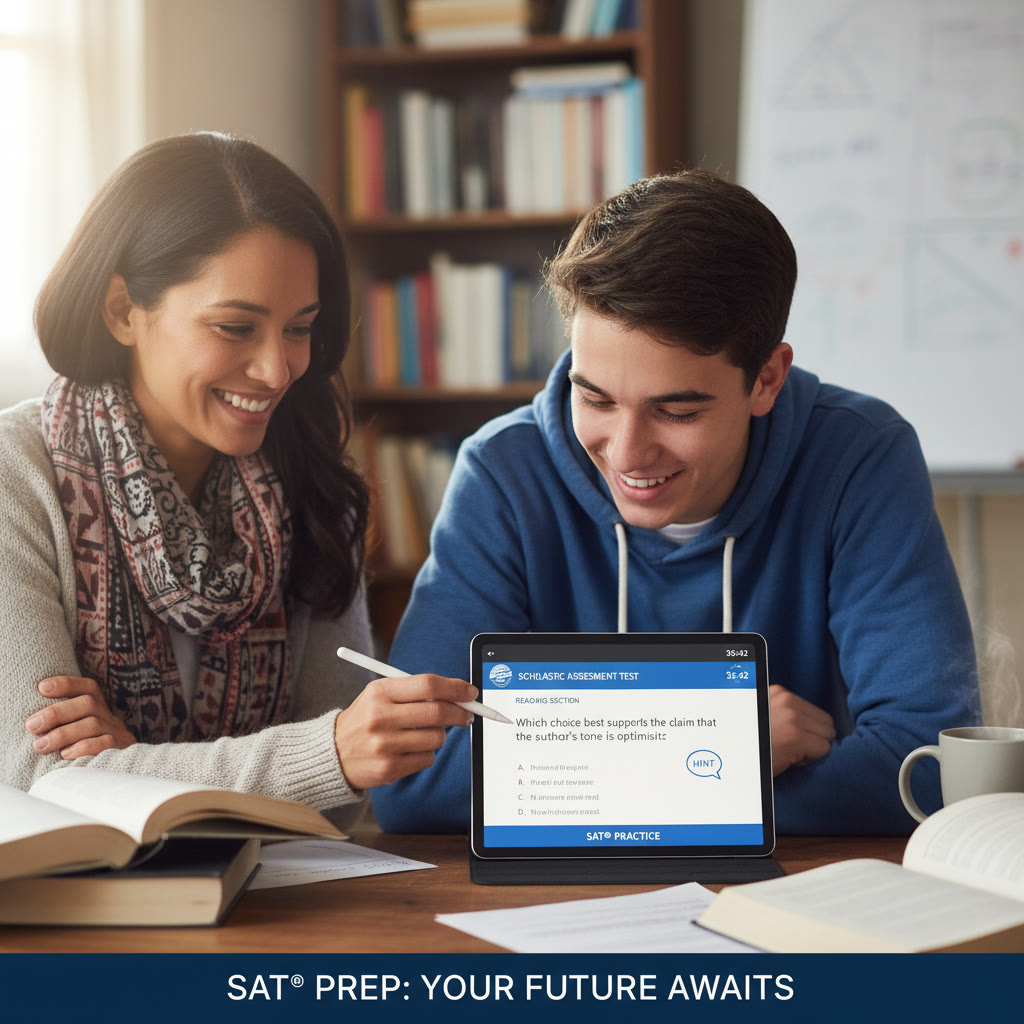Introduction: Why this guide matters
Applying to one of Latin America’s most prestigious institutions — the University of São Paulo (Universidade de São Paulo, USP) — is an exciting, sometimes nerve-wracking chapter for international students and families. If you’re planning to use SAT scores as part of your application or want to position your profile for competitive programs, this guide walks you through the essential landscape in a human, practical way. You’ll get clear explanations, examples, score targets, timeline advice, and study strategies that are realistic for busy students. Along the way I’ll mention how Sparkl’s personalized tutoring can fit into your plan — because tailored help makes a real difference when the stakes are high.

How international applications to USP generally work — and where SAT fits in
USP is primarily a Brazilian public university with competitive admissions processes that traditionally include national exams and specific entrance tests. For many international applicants, especially those educated outside Brazil, universities accept or consider standardized international test scores (like the SAT) as part of a broader review. Admissions rules evolve, and how SAT scores are used can vary by faculty, program, or by the applicant’s pathway (direct international admissions, special programs, or bilateral agreements).
That means the SAT is rarely a one-size-fits-all key: it’s a powerful piece of evidence about academic readiness, but it sits alongside transcripts, language proficiency, letters of recommendation, essays, and, in some cases, subject tests or portfolios (for artistic programs).
Key practical takeaway
- Think of the SAT as a way to strengthen your international academic profile — especially if your high school curriculum is not well-known to USP admissions officers.
- Target the SAT early in the process so you can use multiple scores (if helpful) or demonstrate improvement through official score reports.
- Verify program-specific rules directly with USP admissions before relying solely on SAT timing or scores for application submission.
Common questions families ask (and straightforward answers)
Do I need to take the SAT to apply to USP?
Short answer: not always. Long answer: policies differ. Many international applicants include the SAT to show college readiness in a globally recognized format. For some programs or international admission tracks, the SAT may be recommended or considered; for others it may be optional. You should confirm the requirement for the specific faculty/department you are applying to, and plan as if submitting a strong SAT score will only help your case.
What SAT score should I aim for?
There’s no single “USP cut-off” that applies to every faculty. Instead, think in terms of competitiveness: target a score that places you above the median for selective universities worldwide if you’re aiming for top-tier or highly competitive majors (engineering, economics, law, medicine-related fields often have higher admission pressure).
Practical ranges to consider (these are goal-driven benchmarks to help planning):
| Program Competitiveness | Suggested SAT Target (Total: 1600 scale) | Why this range? |
|---|---|---|
| Highly competitive majors (e.g., engineering, economics) | 1400–1550 | Signals strong readiness and helps offset unfamiliar transcripts. |
| Moderately competitive majors (e.g., humanities, social sciences) | 1250–1400 | Shows solid quantitative and verbal skills; competitive for many programs. |
| Less selective/transfer-friendly programs | 1100–1250 | Demonstrates competency and willingness to improve academically. |
Should I take the digital SAT or a paper one?
College Board shifted to the digital SAT. For international test-takers, the digital format is the prevailing model and offers a shorter, adaptive experience. Preparing for the digital test matters because its pacing and question presentation differ slightly from the old paper test. Practice in the same format you will take on test day.
Timeline and planning: when to take the SAT for a USP application
Planning is an advantage. Build a timeline that leaves room for one or two official test dates and time to send scores before application deadlines. Here’s a simple schedule you can adapt:
- Junior year spring / early senior year fall: take a baseline practice digital SAT and start targeted prep.
- At least one official test by early senior year (6–9 months before major application deadlines) so scores can be reported and, if needed, you can retake the exam.
- If you plan to re-take: schedule a second test at least 6–8 weeks after the first, allowing time for focused study on weaker areas.
- Send official scores well ahead of USP’s deadline; always confirm the deadline for the specific program you’re applying to and for international applicants.
Example timeline (junior/senior year)
- Junior year, spring: diagnostic test and build study plan.
- Summer before senior year: intensive prep (target weak areas), consider a Sparkl personalized tutoring block for 1-on-1 focus.
- Senior year, August–October: first official digital SAT attempt.
- Senior year, October–November: retake if needed and finalize score sends to universities.
How admissions teams view SAT scores — context matters
Admissions officers rarely look at SAT in isolation. They interpret your scores alongside transcripts, coursework rigor, language proficiency (Portuguese/English), recommendation letters, and your personal statement. For USP, demonstrating consistent academic strength and clarity of purpose is crucial. In other words, a high SAT score helps, but a well-rounded application that speaks to alignment with the university’s values and program strengths stands out more.
Practical tip: use scores as a conversation-starter
- High math scores can emphasize quantitative readiness for technical programs.
- Strong reading/writing scores help convey language and critical thinking readiness.
- If one section is weaker, let your essays or recommendation letters explain context (rigorous curriculum, interrupted study, etc.).
Study strategy that actually works
Effective prep balances deliberate practice, review, targeted lessons, and realistic practice testing. Here’s a plan you can adopt — flexible and human-friendly.
Six-month study roadmap
- Month 1: Diagnostic test + set realistic target score. Identify 3 top priorities (example: algebra, evidence-based reading, pacing).
- Months 2–3: Focused skill building. Do timed practice sections twice a week; review mistakes deeply — not just answers but why you made errors.
- Month 4: Full digital practice tests under test conditions once every 10–14 days. Analyze trends and refine question strategies.
- Month 5: Intensify weaknesses. If you’re using Sparkl, this is prime time for 1-on-1 sessions targeting stubborn question types with an expert tutor and AI-driven insight into error patterns.
- Month 6: Test readiness mode: taper new study, emphasize test-day strategies (timing, breaks, device setup), and take the official test.
Tools and practice — what to prioritize
- Practice in the exact digital format — use official College Board digital practice tools whenever possible.
- Quality over quantity: 2–3 full practice tests per month in the final 3 months, and daily short practice (30–60 minutes) focused on weak skills.
- Error logs: keep a small notebook or digital log of mistakes and review them weekly. This is one of the fastest ways to improve.
How to present SAT scores in your USP application
When submitting scores, be deliberate. If USP or the program accepts official score reports, send the most recent and strongest set. If there’s an option to report scores contextually — in a portfolio or an addendum — explain how your test preparation and academic choices reflect your fit for the program.
Sample scenarios
- If your math score is strong but reading is lower: highlight quantitative coursework, projects, or competitions to reinforce your math readiness.
- If your scores improved significantly over time: include a brief note explaining the upward trajectory and what changed (e.g., focused tutoring, advanced coursework).
Language considerations for USP applicants
Since USP is a Portuguese-language institution, many programs expect or require Portuguese proficiency. If you’ll study in Portuguese, demonstrate language readiness through formal tests (if requested), coursework, or letters showing language competence. For programs taught in English or for special international tracks, English proficiency (TOEFL, IELTS, or equivalent) may be required instead of or in addition to Portuguese evidence.
Financial and logistical tips for international applicants
Plan for score-sending fees, test registration, and time-zone considerations for test dates. Research whether colleges require paper documents notarized or translated into Portuguese. Budget for at least one international test date and the official score sends to USP — and always keep time buffer for administrative processing.
How Sparkl can fit naturally into your plan
For many students, adding personalized tutoring shortens the path from baseline practice to target score. Sparkl’s strengths — 1-on-1 guidance, tailored study plans, expert tutors, and AI-driven insights into error patterns — can help you focus on the 20% of practice that produces 80% of score gains. Use Sparkl for targeted blocks: a summer intensive, pre-test polishing, or ongoing weekly sessions that build momentum and confidence.
Common pitfalls and how to avoid them
- Pitfall: Relying on a single test date. Solution: Plan for at least two test attempts when possible.
- Pitfall: Practicing with mismatched formats. Solution: Always practice on the digital platform to mimic test-day experience.
- Pitfall: Ignoring non-score parts of the application. Solution: Spend equal attention on essays, school reports, and recommendation letters — they shape how scores are interpreted.
Checklist: What to do in the 60 days before application deadlines
- Confirm USP program-specific testing policies and deadlines.
- Finalize which scores to send and authorize official score reports.
- Complete any required language tests and arrange translations/certifications of transcripts if needed.
- Polish personal statements and request final recommendation letters.
- If you’re using Sparkl, schedule a final round of targeted tutoring to address last-minute pacing and strategy issues.
Real-world example: A hypothetical applicant
Maria, a student from São Paulo who finished high school abroad, wants to apply to USP’s economics program. Her transcript is strong but the admissions committee is not familiar with her school. Maria takes the digital SAT and scores 1480 with an 800 in Math and 680 in Reading & Writing. She pairs that score with a crisp personal statement, a teacher recommendation highlighting advanced math projects, and proof of Portuguese proficiency for courses in Portuguese. Her SAT score serves to clearly signal quantitative readiness; her application reads cohesively and positions her well for the department’s competitive intake.
When to verify and what to verify
Admissions policies change. Before you finalize any plan or pay for score sends, verify these with USP admissions or the specific faculty:
- Does the specific program accept the SAT as part of the application for international students?
- Are there minimum cutoffs or score expectations for international applicants?
- Are there language exam requirements (Portuguese or English)?
- What is the deadline to receive official score reports?

Final thoughts: balance ambition with strategy
Pursuing admission to USP as an international or non-traditional applicant is a thoughtful process that rewards planning more than last-minute effort. The SAT is an influential and portable signal of academic readiness — use it deliberately. Combine good practice, a sensible timeline, thoughtful presentation of scores, and personalized help where it counts. Whether you choose focused sessions with Sparkl to shore up weak areas or prefer structured self-study, aim for steady, measurable progress.
Quick summary: action items
- Check program-specific SAT and language requirements at USP.
- Take a diagnostic digital SAT and set a realistic target.
- Follow a six-month roadmap with timed practice and periodic full tests.
- Consider Sparkl’s 1-on-1 tutoring and tailored study plans for efficiency.
- Send official scores well before the application deadline and present contextual information when helpful.
What I looked for — and one important note
To prepare this guide I reviewed current, reputable College Board resources about the digital SAT, preparation tools, and score interpretation to ensure test-related facts and practice recommendations are up to date. However, admissions policies at USP (and specific faculty requirements) can change and may be expressed in Portuguese or through faculty-level notices. I recommend verifying the program-level testing policy directly with USP’s admissions office before you finalize your application materials or pay for official score sends.
Need help making a personalized plan?
If you’d like a tailored action plan — a timeline that matches your school calendar, a target score based on your chosen USP program, and weekly practice checkpoints — I recommend booking a few sessions with a tutor who specializes in the digital SAT. Sparkl’s combination of expert tutors, 1-on-1 guidance, tailored study plans, and AI-driven insights can amplify your preparation without overwhelming your schedule.
Good luck: thoughtful planning, steady practice, and a calm test day will take you a long way. If you want, tell me your current SAT baseline, target program at USP, and timeline, and I’ll draft a personalized 3-month study plan you can start tomorrow.


















No Comments
Leave a comment Cancel